Microsoft Surface for Music Production: Surface Book 3 or Surface Go 2?
So you need a new workhorse for mobile music production and you’ve decided to look beyond from Apple’s Mac OS. While the Surface Book 3 pulses with premium power the Surface Go 2 can offer some surprisingly music-friendly stability at a more affordable price point. Which one would make for an awesome DAW platform?
A Surface for every occasion
Microsoft’s laptop game has matured into an attractive lineup of touch-screen hybrids. By the time the Surface Book arrived the Surface Pro had already worked out most of the kinks in the combined touch/keyboard/trackpad workflow. I’ve been a Surface Pro user since version 3 (now on version 7) and I can tell you the ease of use and smoothness of transition between input protocols is superb. With any other laptop or MacBook I find I am confined to a chair and pushed into a singular way of working. With a Surface you can circle it, dodge in and out, walk past with a coffee and tap something, sit down and type, stand up and finger flick. Regular laptops drive me nuts.
Along with the Surface Pro we now have the Surface Laptop, Surface Pro X, Surface Studio, Surface Hub and the forthcoming Surface Duo and Surface Neo. But the focus of this article are the two latest models which define the top and bottom of the range – the flagship Surface Book 3 and the entry-level Surface Go 2.
Surface Book 3
The Surface Book has now reached its third generation and harbours a 10th generation Intel Quad-Core i5 or i7 processor. The 13.5″ or 15″ screen is gorgeous at 3000 x 2000 or 3240 x 2160 resolution respectively running on a Nvidia GTX 1650 4GB or 1660Ti 6GB when attached to the base and drops to the Intel Iris Plus when you pull the screen off via the awesome detachment mechanism. You can opt for 8, 16 or 32GB of memory and 256, 512 or 1TB of storage. Prices start at £1599.
It’s a stunningly made laptop that looks good and feels great and has a respectable amount of power for all your computing needs combined with a ridiculously long battery life. But is it any good for music production?
You are currently viewing a placeholder content from YouTube. To access the actual content, click the button below. Please note that doing so will share data with third-party providers.
Surface Go 2
I got hold of the original Surface Go when it made it to the UK last year and it’s a fabulous little machine. The version 2 ups the processor to an Intel Gold Processor 4425Y or 8th Generation M3. and increases the screen size just a tad to accommodate a more common 1920 x 1280 resolution and aspect ratio. Otherwise the choices of 4 or 8GB of memory and 64 or 128GB of storage remains the same. Prices start at £399.
Can you run any music software on such a little device?
https://youtu.be/NUw8jZl1hX0
Running music software
Right, this is where assumptions and reality have a hard time matching up to one another. The assumption is that if you have a nicely powerful processor then you’ll be able to run masses of plug-ins and instruments and have a lovely time making music. The reality is that laptops are not built with audio production in mind. It’s certainly true that processor speed is your friend in terms of plug-in counts and complex software instruments but that power does not determine the ability for any given laptop to successfully run music software at low, playable latencies.
Now, don’t get me wrong. Buy a powerful laptop and you may well be able to run Ableton Live, Pro Tools, Studio One etc. without any bother. What I am saying is that processor power is no guarantee of a glitch-free music-making experience. The problem comes down to the way the processors work. Mobile processors are designed to save power as much and as often as possible. They clock down as soon as they’re able and only clock back up when the load increases. This clocking or SpeedStepping can cause havoc with realtime audio playback. It can cause spurts of audio glitches or sudden drops in power when a temperature threshold is reached and your plug-in heavy project collapses.
Processor Power
There are ways around these issues that are to do with High-Performance power profiles and disabling the turbo mode. But what alarms me about the Surface Book 3 is that its base processor speed is only 1.3GHz. It can turbo boost up to an extraordinary 3.9GHz which is awesome for any computing task that doesn’t rely on low latency realtime audio. But for audio applications that means there is 2.6GHz of floating power that can’t be reliably fixed to the task of running your DAW. If you turn off turbo mode to get a reliable, stable processor you find yourself with a very expensive Quad Core laptop running at 1.3GHz.
This is where the Surface Go 2 comes in. The Gold Processor 4425Y runs at a steady 1.7GHz. There’s no turbo mode, there’s no clocking up or down and no thermal threshold. The Surface Go 2 will always be able to run the same number of plug-ins and virtual instruments every time you turn it on. There’s no audio glitching, no drops in performance it’s as steady as a rock. Of course the potential of the Surface Book 3 is enormous compared to the Surface Go 2 but what good is potential if your audio is glitching playing a single instrument?
You must be joking?
I wish I was. I should stress that I haven’t tested the Surface Book 3 and so I’m only going on my experience with the Surface platform and other laptops so far. I’ve been testing the Surface Pro generations for music production since version 3. I also reviewed the original Surface Book and Surface Go. Every time it’s slightly different but I’ve always found the right tweaks to get decent performance out of it for music production. This nearly always means turning off turbo mode. This wasn’t a major problem when the stock speed was 2.6GHz so you were only losing a few GHz for the sake of stability. What will happen with the Surface Book 3 is unclear until someone tests it out with music software – you won’t know until you try because no amount of computer-based benchmarks or reviews will tell you anything about glitch-free low-latency audio performance.
By way of example I reviewed the Asus Zenbook Pro Duo UX581GV laptop for Sound On Sound magazine recently. It has extraordinary desktop-level processing power. It would not play a single virtual instrument without glitches in the audio until I turned off the turbo mode. In comparison when I reviewed the original Surface Go with its paltry 1.6GHz processor it ran decent numbers of virtual instruments and plug-ins right out of the box and you could keep on loading it up until it maxed out whereas with more powerful Surfaces you rarely get above 70% CPU before the glitching begins.
Here’s a clip of the Zenbook glitching. The problem was exacerbated by using the touch-screen at the same time but it would glitch all by itself.
You are currently viewing a placeholder content from YouTube. To access the actual content, click the button below. Please note that doing so will share data with third-party providers.
Meanwhile here’s my review of the original Surface Go from last year:
You are currently viewing a placeholder content from YouTube. To access the actual content, click the button below. Please note that doing so will share data with third-party providers.
What now?
We are at a critical time. The method by which I was disabling the turbo mode in Surface products has been squashed by the Windows 10 May 2020 update (2004). They don’t actually like you messing about with power profiles. I’m reliably informed that there is another way to do it but none of my Surface Pros have updated to the new version yet and so I can’t test it out. Hopefully, we can tweak this new Windows 10 update into something helpful. I also hope that we can find stability in the Surface Book 3 because in every other respect it’s an awesome laptop. But we won’t know until I get the opportunity to try it out.
But don’t despair. If you want a cool and reliable little music-making platform then spend £529 on the 4425Y, 8GB, 128GB version of the Surface Go 2. Oh and don’t buy the M3 version as that has a turbo mode too!
More Information
16 responses to “Microsoft Surface for Music Production: Surface Book 3 or Surface Go 2?”
 5,0 / 5,0 |
5,0 / 5,0 | 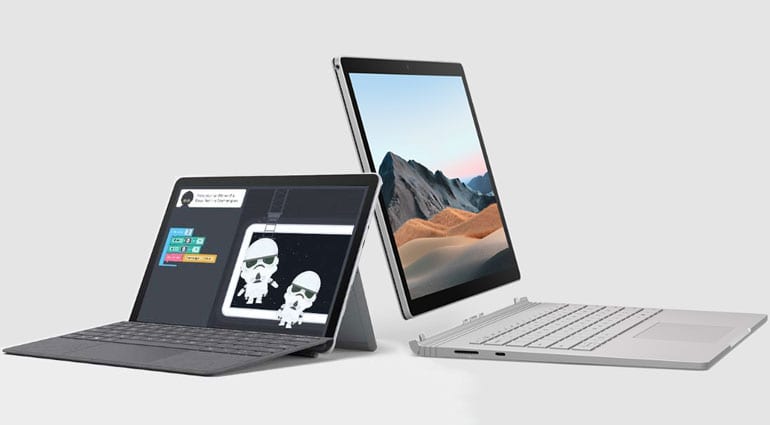

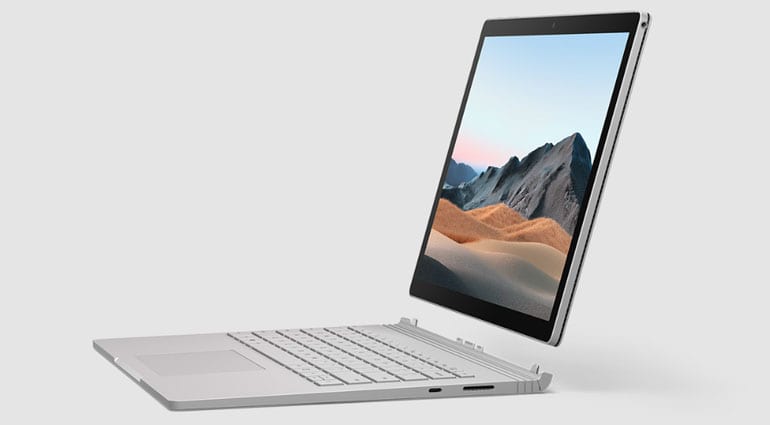
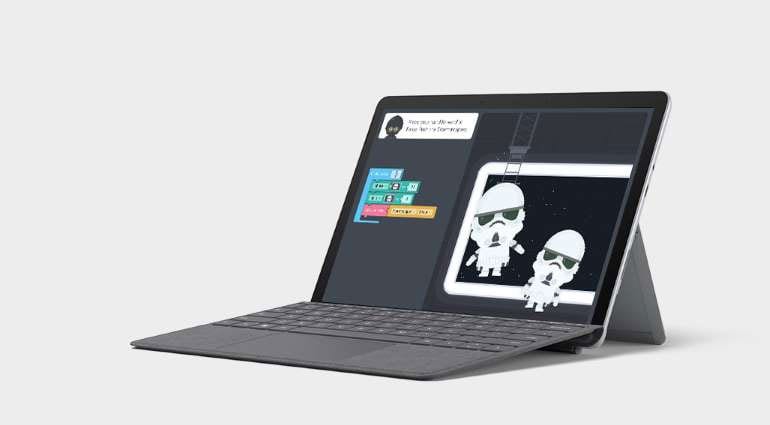
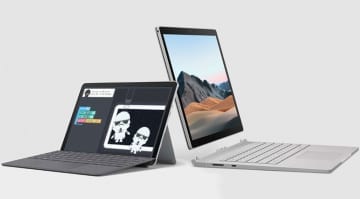

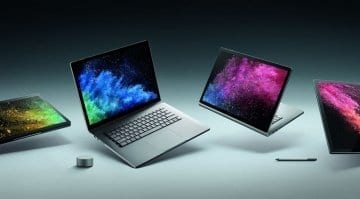
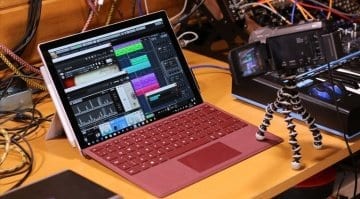
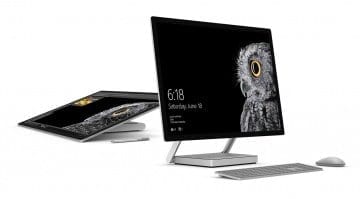
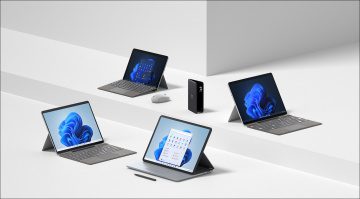
Any news about the new way to disable turbo boost since the update?
Yes, I’m working on that right now as it happens. I’m doing a live stream all about Windows tweaking this Friday and I hope to have it all sorted by then. You’ll find it on my YouTube channel here – https://www.youtube.com/post/UgwCLD2dgMThvNQ1iUZ4AaABCQ
awesome thanks look forward to it!
Would you recommend the Pentium Gold version for Voiceover work?
Voice over work isn’t very strenuous so any computer or phone would be capable of doing it. But check what your software requirements are and make sure the computer you buy matches or exceeds them.
Thanks for the very useful videos. Would the 8GB Gold version of the Go 2 run some of the smaller Kontakt libraries, for realtime playing and practice? I’m not interested in running a DAW or any heavy duty soft synth plugins. Maybe an effect or two if hosted in Cantabile.
For running pro tools on the Microsoft Surface go 2 and having an external monitor setup with an android tablet wirelessly connected as touch midi/keyboard device…would you recommend the surface go 2
I have Surface book 3 and would never recommend anyone to purchase one if you are doing audio productions of any sort. It does not work at all with external audio interfaces . I have tested two different interfaces and the experience with both devices are horrible. Looking to switch away from surface book and never come back.
I know this article is from a couple years ago, but….
I’ve had a Surface Book 2 15″ as my main music production computer for 4 1/2 years now. I’ve been really happy with it — great performance, consistency, beautiful to work with.
I also bought a Go 2 and was very happily surprised. Not nearly equal to the SB2, but I can get a lot done when I’m out of my studio. It’s literally the size of an iPad but can run desktop software surprisingly well.
Both of these computers work great with audio interfaces and external gear, but also with the native WASAPI drivers, which is a great convenience when I’m out and about.
Robin, you got me into Bitwig a few years ago when you reviewed its touch capabilities. I love jamming out in Tablet mode in Bitwig with its multi-touch keyboards and mixer. In my home studio, of course, I have an audio interface and keyboards and controllers. But I love that the Surfaces function so well as completely self-contained music makers with multi-touch keyboards and controls and native audio, no external gear required.
Cool, yeah, Bitwig and the Surface really gel together well. It’s a shame more developers haven’t seen the potential but with the right combination of stuff the Surface is hard to beat.
Thank you for your video even if it’s been a while since
I wanted to know what you think about the go3 today to do a little guitar recording and apply some plugins
Instead of turning turbo mode off, why not force it on, by applying a higher performance power mode and string the minimum cpu speed to 100%?
[“setting”, not “string”!]
Because that doesn’t work. All you achieve is a very hot computer that then clocks down and destroys your project. As I described in the article I believe it’s better to have consistent performance rather than occasionally boosted and then lost performance.
Are your advice still valid today on the surface go2 pentium? I see that the go3 all have the turbo mode that you do not recommend so the trick is to look for the last ones that are still in stock … I have well understood?
I think the advice is still valid – but it really does come down to trying it.
You are currently viewing a placeholder content from Facebook. To access the actual content, click the button below. Please note that doing so will share data with third-party providers.
More InformationYou are currently viewing a placeholder content from Instagram. To access the actual content, click the button below. Please note that doing so will share data with third-party providers.
More InformationYou are currently viewing a placeholder content from X. To access the actual content, click the button below. Please note that doing so will share data with third-party providers.
More Information